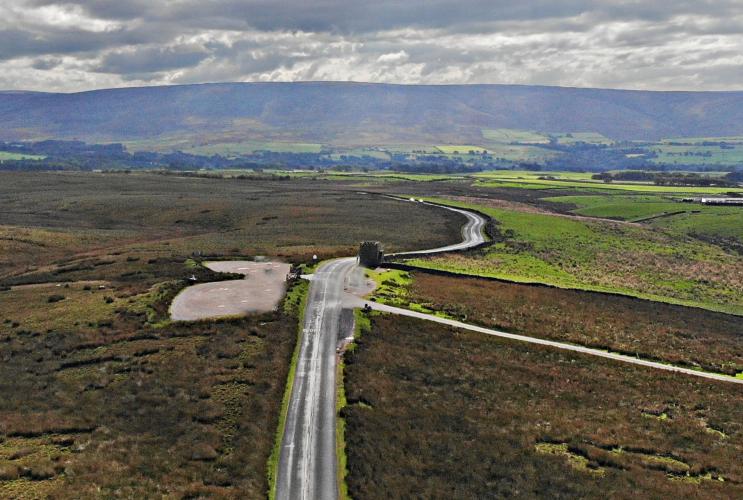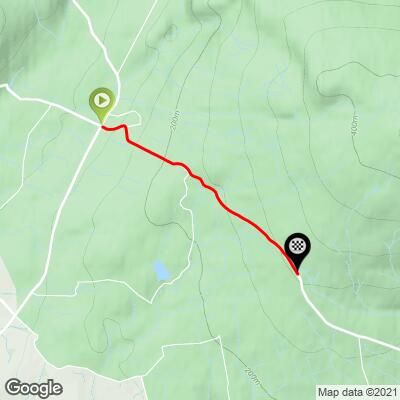![]()
Jubilee Tower - top of climb
![]()
This rural climb begins in Quernmore, Lancashire (pop. 567, 2011) and continues for 3 kilometers at 6.2% to Jubilee Tower. How will you know you have arrived at the end of the climb? After riding for 2.75 km through open meadows and pasture you will reach (1) the high point on the road and (2) a mini medieval tower which Marks the SpotI.
![]()
There is a lot of straight on this climb which begins at the end of a residential land but is completely through open fields and grassland with a golden appearance.
![]()
A pleasant and peaceful ride.
The first 800 meters of the climb are the hardest at 11.4% for 800 meters. The remaining 2.1 kilomesters settles down to a mild 4% with a kilometer of big rollers along the middle kilometer.
![]()
Steepest ½ kilometer begins at 200 meters (12.2%)
Tejvan Pettinger (The Climbing Cyclist) sets the record in 2012:
“. . . The climb is difficult, because you start on a fairly steep gradient, just after the crossroads. The first half a mile is around a pretty steep hairpin (around 14-16%) After this the road gradually eases off. I try to go as fast as I can on the steep bit, without blowing. When you get away from the steep section, you can increase the speed. I tried to keep the pace high when the variable gradient got temporarily steeper so I was in an out of the saddle quite a bit. At one point on the course there was a cattle grid. I was going pretty flat out at this point, but it was well marshalled and I didn’t lose any momentum. I knew I was on a good ride. It was at that ‘sweat spot’ of riding just at the limit and holding it (the feint taste of blood in the mouth – though I’m told it’s not actually blood). The final section is slightly downhill, I worked up into my biggest gear 53*12 – though I wasn’t spinning a high cadence, just mashing the gears using power rather than style.
As soon as I’d finished someone told me, I’d broken the magic 7 minute barrier to do 6.57 – 16 seconds off my old course record. . .
At the fourth attempt, it was very nice to get the course record – especially because there wasn’t a roaring tailwind. I still think, someone can go quicker. Thanks again to Lancaster CC and organisers. And Edge Cycle Works of course!” Full Article
What is “Jubilee Tower”:
“James Harrison was a wealthy Liverpool shipbuilder who lived in Hare Appletree, near Quernmore. To celebrate the Diamond Jubilee of Queen Victoria, he did two things. In a fit of patriotism he lit a beacon on nearby Clougha Pike on the date of the Jubilee, making a precarious assent in his pony and trap. His second deed was rather more enduring- he commissioned a local mason to build a folly view tower. The mason was called Gifford and he had also worked on nearby Quernmore church and chapel. His work endures to today, and the tower is well worth a visit. . .
Just before you climb the steps to the top, look up and see the stone plaque carved into the structure. It says “This tower was erected by James Harrison of Hare Appletree in commemoration of the Jubilee of Her Majesty Queen Victoria ANNO DOMINI 1887”[1]. Lancashirepast.com - full article.
![]()
Date marker near Jubilee Tower
![]()
View north from Jubilee Tower
This climb is in the northwestern section of the Forest of Bowland Area of Natural Beauty
“The Forest of Bowland, also known as the Bowland Fells, is an area of barren gritstone fells, deep valleys and peat moorland, mostly in north-east Lancashire, England with a small part in North Yorkshire (before 1974, some of the area was in the West Riding of Yorkshire). It is a western spur of the Pennines[1] and was once described as the "Switzerland of England".
The Forest of Bowland has been designated an Area of Outstanding Natural Beauty (AONB) since 1964. The Forest of Bowland AONB also includes a detached part known as the Forest of Pendle separated from the main part by the Ribble Valley, and anciently a forest with its own separate history. One of the best-known features of the area is Pendle Hill, which lies in Pendle Forest. There are more than 500 listed buildings and 18 scheduled monuments within the AONB.
Bowland survives as the north-western remainder of the ancient wilderness that once stretched over a huge part of England, encompassing the Forest of Bowland, Sherwood Forest (Nottinghamshire), the New Forest (Hampshire) and Savernake Forest (Wiltshire). While the Trough of Bowland (the valley and high pass connecting the Wyre (at Marshaw) and Langden Brook and dividing the upland core of Bowland into two main blocks) represents the area, to many, on account of its popularity, it is in fact only a small part of the wider Forest of Bowland area.
The hills on the western side of the Forest of Bowland attract walkers from Lancaster and the surrounding area. Overlooking Lancaster is Clougha Pike, the western-most hill. The hills form a large horseshoe shape with its open end facing west. Clockwise from Lancaster the hills are Clougha Pike (413 m or 1,355 ft), Grit Fell (468 m or 1,535 ft), Ward's Stone (561 m or 1,841 ft), Wolfhole Crag (527 m or 1,729 ft), White Hill (544 m or 1,785 ft), Whins Brow (476 m or 1,562 ft), Totridge (496 m or 1,627 ft), Parlick (432 m or 1,417 ft), Fair Snape Fell (510 m or 1,670 ft), Bleasdale Moor (429 m or 1,407 ft), and Hawthornthwaite Fell (478 m or 1,568 ft). Considerable areas of the Bowland fells were used for military training during the Second World War, and there are still unexploded bombs in some areas.
The area contains the geographic centre of Great Britain which is close to the Whitendale Hanging Stones, around four miles (6 km) north of Dunsop Bridge. The historical extent of Bowland Forest is divided into two large administrative townships, Great Bowland (Bowland Forest High and Bowland Forest Low) and Little Bowland (Bowland-with-Leagram), but the modern-day AONB covers a much larger area.” Wikipedia - Forest of Bowland
[1] Note - we think this quote from the article is incorrect as the Jubilee was 1897, not 1887.

 We've partnered with Sherpa-Map.com to bring you the best route planning tool. With a PRO Membership you can use this climb as a reference when creating your route.
We've partnered with Sherpa-Map.com to bring you the best route planning tool. With a PRO Membership you can use this climb as a reference when creating your route. 

